- Ordinal NFT Market Insights
- What Is An Ordinal NFT Marketplace?
- How Does An Ordinal NFT Marketplace Work?
- How Are Ordinals Marketplaces Different From a Traditional NFT Marketplaces?
- Types of Ordinal NFT Marketplaces
- Business Benefits Of Developing An Ordinal NFT Marketplace
- Use Cases Of Ordinal Nft Marketplace
- Must Have Features In An Ordinal NFT Marketplace
- Top 5 Ordinal NFT Marketplace In The Market Right Now
- Cost Affecting Factors To Consider To Develop An Ordinal NFT Marketplace
- How To Develop An Ordinal NFT Marketplace?
- Tech Stack To Consider To Develop An Ordinal NFT Marketplace
- Conclusion
- FAQ
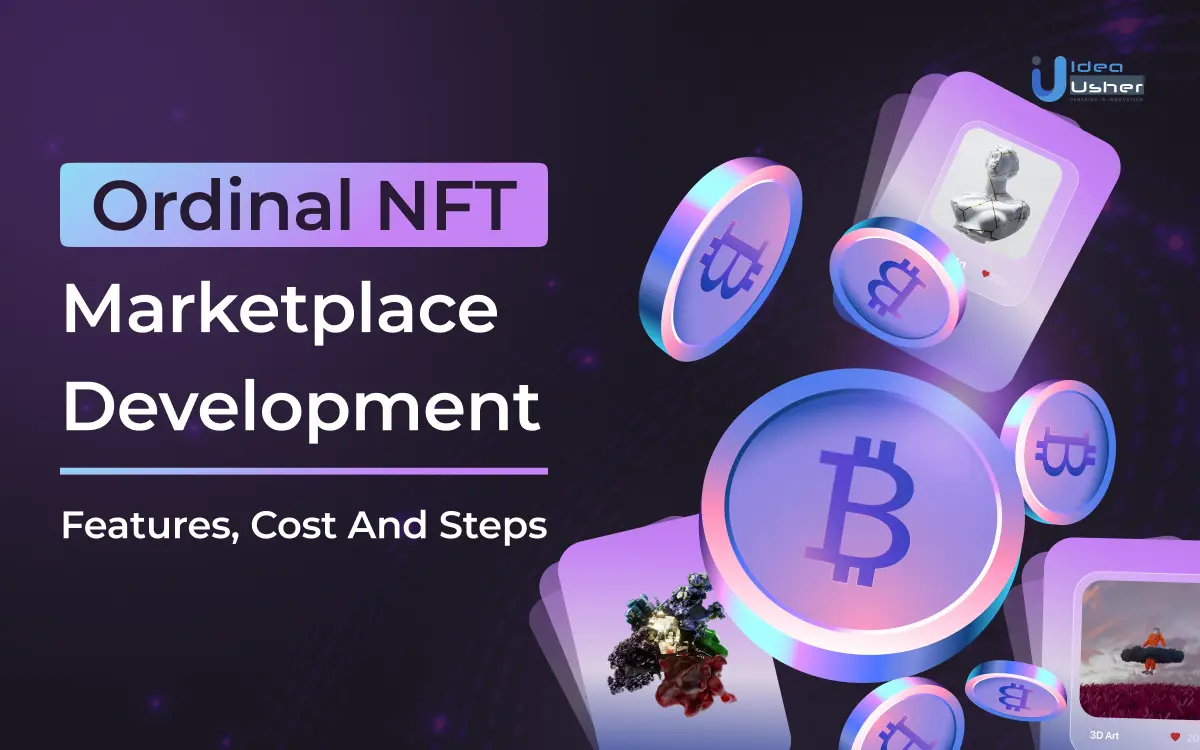
Non-fungible tokens (NFTs) have been frequently linked to blockchains like as Ethereum, Solana, and Stellar. With the advent of ordinals, NFT development has created several business opportunities, one of which is ordinary marketplace development.
With the increased number of NFT users, an NFT development business may capitalize on this opportunity. Ordinal marketplaces facilitate the development and exchange of Bitcoin ordinals, in the same way as NFT marketplaces do for NFTs.
These platforms have the potential to increase the NFT ecosystem’s relevance, particularly at a time when NFT applications are gaining importance. Various platforms help to develop the traditional marketplace business model.
In this blog, understand various aspects of an ordinal NFT marketplace development such as development steps, must have features, cost estimating factors, tech stack and so on.
- Ordinal NFT Market Insights
- What Is An Ordinal NFT Marketplace?
- How Does An Ordinal NFT Marketplace Work?
- How Are Ordinals Marketplaces Different From a Traditional NFT Marketplaces?
- Types of Ordinal NFT Marketplaces
- Business Benefits Of Developing An Ordinal NFT Marketplace
- Use Cases Of Ordinal Nft Marketplace
- Must Have Features In An Ordinal NFT Marketplace
- Top 5 Ordinal NFT Marketplace In The Market Right Now
- Cost Affecting Factors To Consider To Develop An Ordinal NFT Marketplace
- How To Develop An Ordinal NFT Marketplace?
- Tech Stack To Consider To Develop An Ordinal NFT Marketplace
- Conclusion
- FAQ
Ordinal NFT Market Insights
Here are few market stats indicating why it is a great opportunity for businesses seeking to enter in ordinal NFT marketplace with platform development.

Image Source: Galaxy.com
- According to a Galaxy Research, the market for Bitcoin NFTs based on Inscriptions and Ordinals would reach $4.5 billion by 2025.
- In the first 200 days following the initial Bitcoin inscription, a total of 1.14mn image-based inscriptions were made. This figure exceeds the entire quantity of NFTs created on Ethereum, Solana, and Polygon in the first 200 days since the first NFT was minted on their respective networks.
What Is An Ordinal NFT Marketplace?
Ordinal NFT marketplaces serve as dedicated platforms tailored for the creation, trade, and exchange of NFTs, also known as Non-Fungible Tokens. These unique digital assets are crafted using the innovative concept of Bitcoin ordinals, setting them apart from conventional NFTs typically associated with blockchains like Ethereum, Solana, or Stellar.
The term “ordinal” denotes a sequential numbering system assigned to individual satoshis, the smallest units of Bitcoin, based on their mining order. Ranging from 0 to 4,999,999,999, this numbering system forms the foundation for crafting distinctive digital assets on the Bitcoin blockchain. The process involves attaching information to these satoshis through a method known as inscribing.
Within the realm of the blockchain, ordinal NFT marketplaces assume a crucial role by providing a dedicated space for creators and collectors to actively participate in developing and exchanging these unique digital assets. Like traditional NFT marketplaces, these platforms empower users to buy, sell, and showcase their ordinal NFTs.
They contribute significantly to the growth of the Bitcoin ecosystem, presenting enticing opportunities for artists, developers, and collectors to immerse themselves in the evolving field of ordinal NFTs.
How Does An Ordinal NFT Marketplace Work?
An Ordinal NFT Marketplace operates as a unique platform where digital assets are traded and represented as non-fungible tokens. Here is the detailed working of ordinal NFT marketplace:
1. Ordinal Generation
Bitcoin ordinals form the backbone of ordinal NFTs, establishing a unique sequential numbering system for individual satoshis, the smallest units of Bitcoin. This numbering process, ranging from 0 to 4,999,999,999, is crucial for creating exclusive digital assets on the Bitcoin blockchain. As new satoshis are mined, they are assigned ordinal numbers based on the order of their creation. This sequential arrangement becomes the foundation for the distinctiveness of ordinal NFTs within the blockchain.
2. Creating Ordinal NFTs
Ordinal NFTs come to life through a process called inscribing, where specific information is attached to the assigned satoshis. This information include a wide range of details, such as the NFT’s provenance, historical context, or even multimedia content. By inscribing this data, each ordinal NFT gains unique characteristics, enhancing its value and differentiating it from other digital assets on the Bitcoin blockchain. The inscribing process plays a pivotal role in creating a one-of-a-kind identity for each ordinal NFT.
3. Platform Setup
Dedicated ordinal NFT marketplaces serve as centralized hubs for users, including creators and collectors, to engage in the lifecycle of these unique digital assets. These platforms provide a user-friendly interface, akin to traditional NFT marketplaces, where users can explore, buy, sell, or showcase their ordinal NFTs. The marketplace serves as a community-driven space, fostering interactions among participants and contributing to the growth of the ordinal NFT ecosystem.
4. Trade and Exchange
Transparent and secure transactions lie at the core of ordinal NFT marketplaces. Trades and assets are recorded on the immutable Bitcoin blockchain, ensuring a verifiable transaction history. Creators and collectors have the opportunity to monetize their work by selling or trading their ordinal NFTs within the marketplace. This seamless exchange process, backed by blockchain technology, establishes trust and authenticity in the ordinal NFT market.
5. Wallet Integration
Users can seamlessly integrate their Bitcoin wallets with the ordinal NFT marketplace, ensuring secure storage and complete ownership of their digital assets. This integration is crucial for users to have full control over their ordinal NFTs, allowing them to manage, transfer, or showcase their unique digital assets with ease. Wallet integration enhances the overall user experience and reinforces the decentralized nature of the ordinal NFT ecosystem.
6. NFT Marketplace Features
Ordinal NFT marketplaces often boast innovative features, such as advanced inscribing capabilities, secure payment gateways, and interoperability with other NFT marketplaces. These features contribute to the richness of the platform, providing users with tools to enhance and customize their ordinal NFTs. The seamless integration of cutting-edge features fosters creativity and diversity within the ordinal NFT ecosystem.
7. Assets Diversification
The appeal of ordinal NFT marketplaces lies in their support for a diverse range of digital assets. Whether it’s text, images, or GIF representations, users can trade and showcase various forms of content within the marketplace. This diversification not only enriches the ecosystem but also caters to the varied interests and preferences of creators and collectors. The platform becomes a dynamic space where a plethora of digital assets find a home and contribute to the vibrant ordinal NFT marketplace.
How Are Ordinals Marketplaces Different From a Traditional NFT Marketplaces?
Ordinal markets differ from regular NFT marketplaces by introducing a structured hierarchy or order for non-fungible tokens (NFTs). Each NFT is allocated a certain rank or significance in Ordinal markets based on specified criteria such as rarity or other qualities.
In contrast, typical NFT systems frequently value assets separately, with no systematic order or hierarchy. The use of ordinals in these markets adds an additional layer of organisation and ranking, offering a distinct approach to digital asset value and appealing to collectors looking for a more complex and organised experience inside the NFT ecosystem.
Types of Ordinal NFT Marketplaces
Depending on the individual demands and aims of the organisation, several types of ordinal NFT markets can be built. Here are a few examples of the most common types:
1. General Ordinal NFT Marketplace
The General Ordinal NFT Marketplace stands as a versatile platform catering to a broad spectrum of creators and collectors. By offering various limited-edition collections or sets of ordinal NFTs, this marketplace facilitates creators in monetizing digital content while providing collectors with opportunities to invest in rare and valuable items.
2. Art-Focused Ordinal NFT Marketplace
Centered around limited-edition collections or sets of NFTs representing unique positions within art series or collections, this marketplace becomes a specialized platform. It not only offers emerging artists an avenue to showcase their work and generate revenue but also provides art enthusiasts with a distinctive and exclusive experience in the world of digital art.
3. Sports Memorabilia Ordinal NFT Marketplace
Sports Memorabilia Ordinal NFT Marketplace introduces limited-edition collections or sets of NFTs that represent unique positions within specific sports memorabilia collections.
This marketplace innovatively combines the world of sports with blockchain technology, offering collectors a novel way to invest in rare and valuable sports memorabilia while delivering an exclusive collectibles experience to sports fans.
4. Music-Focused Ordinal NFT Marketplace
Geared towards musicians and music collectors, the Music-Focused Ordinal NFT Marketplace brings forth limited-edition collections or sets of NFTs representing unique positions within music albums or collections. This marketplace creates a new revenue stream for musicians, providing a unique and exclusive music experience for collectors. It combines the passion for music with the blockchain, enriching the music industry’s landscape with innovative monetization opportunities.
5. Gaming-Focused Ordinal NFT Marketplace
The Gaming-Focused Ordinal NFT Marketplace redefines the gaming industry by offering limited-edition collections or sets of NFTs representing unique positions within specific gaming experiences or collections.
Gamers are presented with an innovative way to invest in rare and valuable gaming items, adding a unique layer to their gaming pursuits. This marketplace not only caters to the investment aspect but also offers a distinctive and exclusive gaming experience for enthusiasts.
Business Benefits Of Developing An Ordinal NFT Marketplace
Ordinal marketplace development brings various benefits, from a global scope for businesses to an immutable on-chain presence. The detailed business benefits of Ordinary NFT marketplace development are as follows.
1. Market Differentiation
Establishing an Ordinal NFT marketplace sets your business apart within the competitive NFT landscape. The ordinal approach, which involves ranking digital artifacts based on various criteria, delivers a unique and captivating user experience. This distinctiveness has the potential to attract users actively seeking novel and gamified elements within the NFT ecosystem.
2. Innovative Trading Dynamics
Ordinal NFTs bring a fresh perspective to trading dynamics by introducing the ordinal ranking system. This encourages users to engage in strategic trading and collecting of digital artifacts, thereby creating a dynamic and interactive marketplace. This innovative approach can draw in a diverse user base, including collectors and traders, fostering heightened engagement and increased transactional activity.
3. Enhanced User Engagement
The gamified nature of ordinal rankings significantly amplifies user engagement. Participants are driven to explore, collect, and trade NFTs with the aim of attaining higher ordinal standings. This interactive and competitive element contributes to the development of a vibrant and engaged community, sustaining long-term user interest.
4. Creator Incentives and Recognition
An Ordinal NFT marketplace serves as a platform for creators to receive recognition and incentives. The ranking system enables creators to present their digital artifacts, attracting collectors and fans. Increased visibility and appreciation motivate creators to contribute more actively, fostering the growth of a thriving ecosystem.
5. Monetization Opportunities
For business owners, an Ordinal NFT marketplace unveils diverse opportunities for monetization. Revenue streams can be generated through transaction fees, premium rankings, and collaborations with highly-ranked creators. The distinctive features of ordinal NFTs also make the platform appealing for potential partnerships and sponsorships, enhancing its financial viability.
6. Community Building and Loyalty
The ordinal approach facilitates the establishment of a tightly-knit community. Users actively engaging in gamified exploration and trading become integral members of a dynamic community. Building a sense of belonging and loyalty among users contributes significantly to the long-term sustainability of the marketplace.
7. Strategic Partnerships
The innovative nature of an Ordinal NFT marketplace positions it attractively for forming strategic partnerships with artists, influencers, and entities interested in the ordinal NFT space. Collaborations with high-ranking creators or well-known brands have the potential to elevate the marketplace’s visibility and credibility, paving the way for mutually beneficial partnerships.
8. Adaptability and Flexibility
Ordinal NFT marketplaces exemplify adaptability and flexibility. The ranking system can be tailored to align with different criteria, seasonal themes, or promotional events. This adaptability ensures the platform stays relevant, catering to evolving user preferences, and remains at the forefront of the continually evolving NFT industry.
9. Data-Driven Insights
The ordinal ranking system generates invaluable data on user preferences, trading patterns, and popular digital artifacts. Business owners can leverage these insights for informed decision-making, effective content curation, and targeted marketing strategies, enhancing the overall efficiency and effectiveness of the marketplace.
Use Cases Of Ordinal Nft Marketplace
NFT marketplaces employ ranking systems to introduce gamified exploration, curated collections, and innovative financial services, shaping a multifaceted ecosystem. Here are a few use cases of ordinal NFT marketplace:
1. Digital Art Collections
Example: ArtRank
Ordinal NFT marketplace, categorizes digital art collections based on their rarity and historical significance. Artists and collectors on ArtRank benefit from a structured hierarchy, allowing for a more nuanced appreciation of digital artworks within the NFT ecosystem.
2. Music Royalties Hierarchy
Example: TuneToken
TuneToken integrates ordinal properties to its NFT marketplace, providing a structured hierarchy for music royalties. Artists can tokenize their music rights, and investors can navigate a clear order of value based on factors such as streaming popularity and historical revenue, fostering a transparent music NFT ecosystem.
3. Gaming Assets Ranking
Example: PlayNFTs
PlayNFTs utilizes ordinal features to establish a structured order for gaming assets. This Ordinal NFT marketplace ranks in-game items based on their rarity and utility, creating a dynamic environment where gamers can trade assets with a clear understanding of their relative significance.
4. Real Estate Tokenization
Example: RankEstate
RankEstate transforms real estate tokenization by implementing ordinals. Properties within this Ordinal NFT marketplace are assigned ranks based on factors like location, historical value, and demand. This structured hierarchy enhances transparency and valuation precision in the real estate NFT sector.
5. Collectible Card Game
Example: RankCardArena
RankCardArena employs ordinals for a collectible card game NFT marketplace. Each virtual card is assigned a specific rank based on rarity and in-game performance. This Ordinal NFT marketplace provides a strategic layer to the trading and competition among collectors in the digital card gaming community.
Must Have Features In An Ordinal NFT Marketplace
The development of an Ordinal Marketplace requires a thoughtful integration of features to enhance user experience and foster a thriving ecosystem. Here are key features that elevate the functionality of an Ordinal Marketplace,
1. Inscribing NFTs with the Ordinal Protocol
Inscribing NFTs through the Ordinal protocol introduces a unique layer of value and authenticity to digital assets. By embedding essential information such as provenance, historical context, or multimedia content directly into the NFT, creators enhance the overall narrative and distinctiveness of their work. This feature not only serves as a creative tool but also establishes a transparent connection between the creator and the collector, fostering a deeper appreciation for the digital art or asset.
2. Buying and Selling NFTs
Ordinal marketplaces stand as robust platforms facilitating transparent and secure transactions for the buying and selling of NFTs. Creators and collectors benefit from a seamless trading experience, leveraging blockchain technology to record all transactions on-chain. This transparency not only builds trust among users but also ensures the legitimacy and ownership of digital assets within the marketplace.
3. Transaction History
Ordinals prioritize transparency by offering users the ability to view their transaction history within the marketplace. This feature allows creators and collectors to track their interactions and transactions, promoting accountability and trust among users. The display of transaction history enhances the overall user experience and contributes to the credibility of the platform.
4. Secure Transactions
Security is paramount in Ordinal marketplaces, with a commitment to providing users the highest level of confidence in their transactions. By recording all trades and assets on-chain, the marketplace minimizes the risk of fraudulent activities and unauthorized alterations. This focus on security creates a reliable environment for creators and collectors to engage in the monetization of their digital assets.
5. Payment Gateway Integration
By integrating a payment gateway, Ordinal marketplace allows users to purchase NFTs using fiat currencies. This feature broadens the user base by eliminating barriers related to cryptocurrency adoption, making the marketplace more accessible to a diverse audience of art enthusiasts and collectors.
6. NFT Wrapping
The capability to wrap NFTs for interoperability expands the market reach of Ordinal marketplaces. Users can seamlessly trade their assets on different NFT marketplaces built on diverse blockchains, fostering a more interconnected and collaborative ecosystem within the digital asset space.
7. Verification Protocols
To safeguard against fraud and ensure authenticity, Ordinal marketplaces implement robust verification protocols. These protocols utilize anti-fraud detection tools and compliance checks, providing creators and collectors with the assurance that the content on the platform is genuine and original. This commitment to authenticity enhances the marketplace’s reputation and builds trust among its users.
8. Assest Diversification
Ordinal marketplace development goes beyond the traditional scope of NFTs, allowing for the trading of various digital asset types. This diversification fosters a dynamic ecosystem where creators can explore different forms of digital art, music, or other innovative digital assets, contributing to the richness and variety of content available on the platform.
9. Encryption
Ensuring the utmost security, Ordinal marketplaces implement peak-level encryption to protect user data and transaction information. This advanced encryption technology safeguards the platform against potential cybersecurity threats, providing users with a secure environment for their digital asset transactions.
10. Multiple Crypto Wallets for Storage, Selling/Buying NFTs
Ordinal marketplaces support the use of multiple crypto wallets, giving users flexibility in managing their digital assets. Whether storing, selling, or buying NFTs, users can choose from various compatible wallets, allowing for a personalized and user-friendly experience within the marketplace.
11. Wide Range of NFTs Collections
The diversity of NFT collections within Ordinal marketplaces adds vibrancy to the platform. From digital art and virtual real estate to music and virtual goods, the marketplace accommodates a wide range of NFT collections, catering to different tastes and preferences within the digital asset community.
12. Admin Panel
A robust admin panel is a cornerstone of Ordinal marketplace development, providing administrators with the tools to manage and oversee platform operations efficiently. From user management to content moderation, the admin panel ensures smooth and secure day-to-day operations, contributing to the overall success and reliability of the marketplace.
Top 5 Ordinal NFT Marketplace In The Market Right Now
Several Ordinal NFT marketplaces have emerged, offering unique structures that enhance the rarity and value of digital assets. Here are the top 5 Ordinal NFT marketplaces leading the way in providing curated experiences for collectors and creators.
1. Ordinals Market
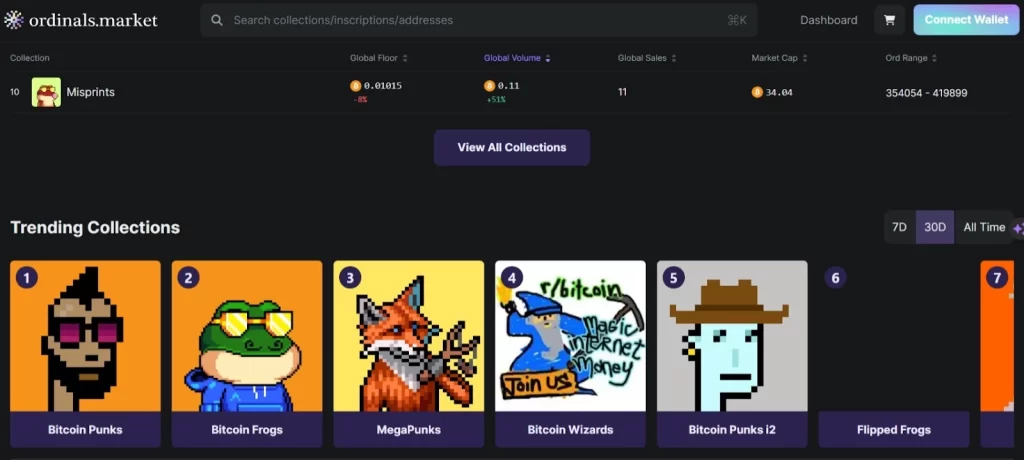
Ordinals Market emerges as a prominent platform for the trade of Bitcoin inscriptions on the Ethereum blockchain. The marketplace introduces an innovative feature known as ‘vaults’ to enhance accessibility and security. These vaults, resembling treasure chests on the Ethereum blockchain, securely store the private keys to Bitcoin inscriptions.
Users enjoy the flexibility to either claim their Bitcoin inscriptions on the Bitcoin network by unlocking the vault or retain them within the Ethereum vault for seamless trading and transfers. This distinctive approach contributes a layer of versatility to the trading experience offered by Ordinals Market.
2. Magic Eden
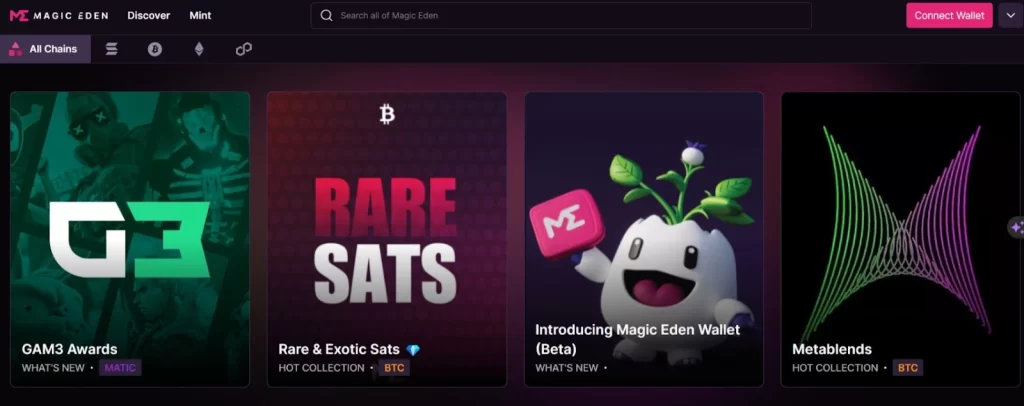
Magic Eden introduces a creator launchpad specifically tailored for Bitcoin ordinals. Launched on April 7, 2023, this platform facilitates artists in inscribing their artwork directly onto the Bitcoin blockchain, streamlining the process for creators to bring their collections to market. While Magic Eden provides assistance to creators during the inscription process, it’s crucial to note that the platform currently lacks support for royalties due to the absence of secure and trustless royalty enforcement tools in the ordinals ecosystem.
3. Gamma
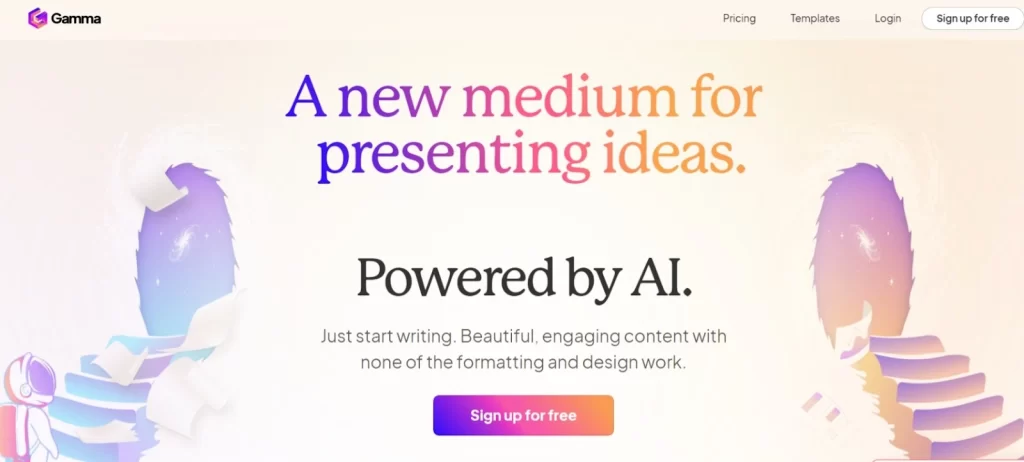
Gamma presents a versatile platform featuring three key components: a marketplace for discovering and collecting ordinals, a launchpad enabling artists to create ordinals without coding, and a social platform encouraging interaction between creators and collectors.
Whether users are novices or experienced collectors in the digital artifacts realm, Gamma offers a user-friendly and engaging environment. The marketplace facilitates the discovery and collection of ordinals, the launchpad streamlines the creation process for artists, and the social platform promotes interaction within the community of ordinals enthusiasts.
4. Ordswap

Ordswap provides a user-friendly marketplace equipped with various features to cater to both buyers and sellers of ordinals NFTs. Users can effortlessly engage in the buying and selling of ordinals NFTs, coupled with access to an inscription platform for creating digital artifacts conveniently and cost-effectively. Notably, users can explore specific collections of ordinals through efficient filtering options. Additionally, the ‘activity’ tab on the website delivers real-time updates on the latest trades, fostering a dynamic and well-informed trading community.
5. OKX NFT Marketplace
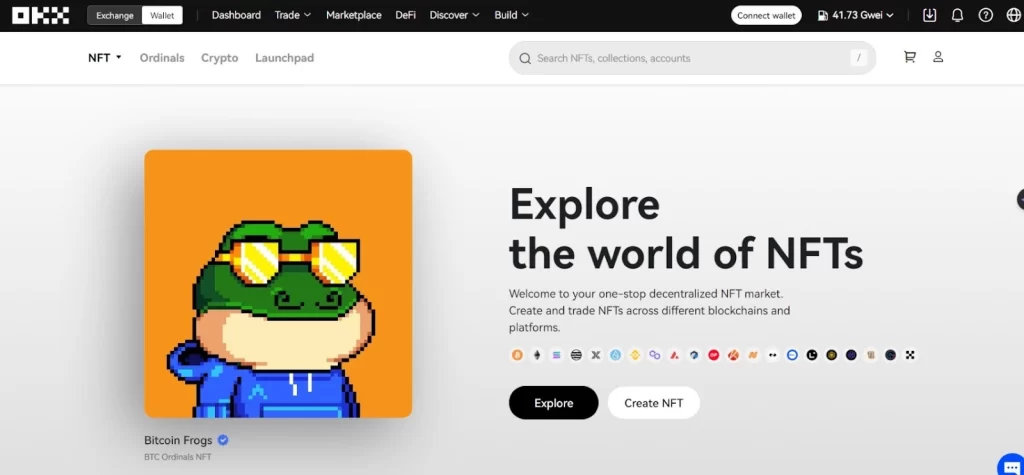
OKX stands out in the NFT space by providing a seamless entry into the realm of Bitcoin ordinals through its innovative OKX Wallet. The wallet’s browser extension currently supports BTC taproot addresses, with mobile support in active development.
With a focus on interoperability and user-friendliness, the OKX Wallet enables users to import all their Bitcoin addresses and view their inscriptions on a unified interface. This streamlined experience eliminates the need for managing multiple wallets, making OKX an accessible and efficient choice for exploring the world of Bitcoin ordinals.
Cost Affecting Factors To Consider To Develop An Ordinal NFT Marketplace
Developing NFT Marketplace requires careful consideration of various cost-affecting factors. Here are key elements influencing the financial landscape of creating a structured and innovative platform for ordinal non-fungible tokens.
1. Smart Contract Optimization
The intricacy of smart contracts significantly impacts development costs. Integrating advanced ordinal features, such as structured hierarchies or intricate ranking algorithms, may necessitate complex smart contract logic, influencing both the time and costs involved in development.
2. Blockchain Platform Selection
The choice of a blockchain platform plays a pivotal role in determining development costs. Ethereum, while popular, tends to be costlier due to its robust smart contract capabilities. Exploring alternative, cost-effective platforms like Binance Smart Chain or Polygon can be a strategic decision based on project requirements.
3. Implementing Security Measures
The implementation of robust user authentication and security measures is paramount for safeguarding user accounts and transactions. Developing and integrating secure authentication systems and encryption protocols may contribute to the overall development costs but is crucial for maintaining a secure Ordinal NFT marketplace environment.
4. Scalability Needs
Knowing scalability needs is crucial, particularly for a rapidly growing marketplace. Constructing a scalable architecture capable of accommodating a larger user base may require additional development efforts and investments in infrastructure, influencing overall costs.
5. Frontend and UX Design
Creating an intuitive and visually appealing frontend is pivotal for user adoption. Investing in experienced UX/UI designers and frontend developers might increase costs but is essential for delivering a seamless and engaging user experience within the Ordinal NFT marketplace.
6. Blockchain Transaction Fees
Transaction fees on the chosen blockchain can significantly impact the overall operational costs of the Ordinal NFT marketplace. Understanding and estimating these fees, especially during peak usage, is vital for effective budget planning and optimizing the economic model of the platform.
7. Legal Compliance and Certifications
Compliance with legal requirements and regulations in the jurisdictions where the marketplace operates is essential. Costs associated with legal consultations, regulatory compliance measures, and obtaining necessary licenses or certifications should be carefully considered and factored into the overall development budget.
8. Conducting Thorough Testing and Quality Assurance
Thorough testing is crucial for ensuring the reliability and security of the Ordinal NFT marketplace. Allocating resources for extensive testing and quality assurance processes may contribute to upfront costs but is a critical investment in identifying and addressing issues before deployment, preventing potential costly setbacks.
9. Community Engagement and Marketing
Building and engaging a community around the Ordinal NFT marketplace is vital for success. Allocating resources for marketing, community management, and outreach activities contributes to the overall cost but is crucial for attracting users and creators to the platform.
10. Ongoing Maintenance and Updates
Ongoing maintenance and updates are necessary to address emerging issues, introduce new features, and ensure the long-term viability of the Ordinal NFT marketplace. Budgeting for continuous development and support is essential for sustaining the success and relevance of the platform in a dynamic market landscape.
How To Develop An Ordinal NFT Marketplace?
Creating an Ordinal NFT Marketplace involves crafting a digital trading platform where non-fungible tokens (NFTs) are traded and valued based on a structured hierarchy or order. Here are detailed steps of developing an ordinal NFT marketplace:
1. Conceptualization and Planning
In the initial phase of creating an Ordinal NFT Marketplace, meticulous conceptualization and planning are crucial. Consider innovative features that will distinguish your marketplace within the competitive NFT landscape.
Additionally, strategize the hierarchical structure, whether it revolves around rarity, artist reputation, or other distinctive criteria. A well-crafted concept and plan serve as a guiding framework, attracting a specific audience and laying the foundation for a successful development journey.
2. Blockchain Selection
The choice of blockchain significantly influences the success of your Ordinal NFT Marketplace. Ethereum, renowned for its robust smart contract capabilities, is a popular selection, offering a mature and widely adopted ecosystem.
Conversely, Binance Smart Chain provides an alternative with lower transaction fees, appealing to cost-conscious users. Conduct a thorough evaluation of the pros and cons of each blockchain, aligning the final decision with the overarching goals of your project for optimal performance and user satisfaction.
3. Smart Contract Development
Smart contracts serve as the backbone of any NFT marketplace, and for an Ordinal NFT Marketplace, custom logic is paramount. Develop smart contracts adhering to NFT standards, such as ERC-721, and integrate bespoke functions for ordinal properties. These functions could include mechanisms to calculate and determine the ranking of NFTs based on specific attributes or criteria, enriching the uniqueness and value of each digital asset within the marketplace.
4. Token Standards and Metadata
Selecting the right token standard is fundamental for ensuring interoperability and compatibility with wallets and external platforms. ERC-721 remains a widely accepted standard for NFTs, providing the necessary framework for seamless transactions. In parallel, define comprehensive metadata standards to offer users detailed information about each NFT, including artist details, creation date, and other pertinent data, enhancing transparency and user trust.
5. User Authentication and Wallet Integration
Establishing a secure user authentication system is paramount for protecting user accounts and transactions. Seamlessly integrate popular cryptocurrency wallets like MetaMask or Trust Wallet to simplify the buying and selling process for users. Prioritize user privacy and security measures to instill trust among the platform’s users, fostering a secure environment conducive to active participation and transactions.
6. Frontend Development
The user interface is the gateway to your Ordinal NFT Marketplace. Design an intuitive, visually appealing frontend that allows users to effortlessly explore and interact with NFTs. Incorporate features for sorting and filtering based on ordinal properties, ensuring a smooth and engaging user experience. A well-designed frontend contributes significantly to user satisfaction and retention within the marketplace.
7. Backend Development
Develop a robust backend system capable of handling transactions, user data, and smart contract interactions. Scalability is critical, especially as the marketplace grows in terms of users and transaction volume. Implement advanced security measures to protect against potential threats, ensuring a reliable and secure environment for users to buy, sell, and engage with NFTs on the platform.
8. Testing
Comprehensive testing is a crucial step before the marketplace goes live. Rigorously test every aspect, including smart contracts, frontend functionality, and security features. Identify and address any bugs or issues that may arise during testing to ensure a stable and reliable marketplace experience for users upon launch.
9. Deployment
Once testing is successfully completed, deploy the smart contracts on the chosen blockchain. Launch the frontend and backend components to make the Ordinal NFT Marketplace accessible to users. Monitor the deployment carefully to address any unforeseen issues promptly, ensuring a smooth and successful launch.
10. Community Engagement and Marketing
Strategic community engagement and marketing efforts are essential for the visibility and success of your Ordinal NFT Marketplace. Utilize social media, forums, and other channels to create awareness. Foster a sense of community to attract artists, collectors, and enthusiasts, promoting active participation and content creation within the platform.
11. Maintenance and Updates
Regular maintenance and updates are critical for the long-term success of your Ordinal NFT Marketplace. Address emerging issues promptly and consider user feedback for future updates. Proactively evolve the platform in response to the evolving needs and preferences of your user base, ensuring a dynamic and engaging user experience over time.
Tech Stack To Consider To Develop An Ordinal NFT Marketplace
Developing an ordinal NFT (Non-Fungible Token) marketplace involves a combination of technologies to ensure a robust and secure platform. Here’s a comprehensive tech stack that you might consider:
1. Blockchain Platform
- Ethereum
- Solana
2. Smart Contracts
- Solidity
- Rust
3. Testing Frameworks
- Truffle
- Hardhat
4. Wallet Integration
- MetaMask
- WalletConnect
5. Frontend Development
- React
- Vue.js
- Angular
6. Backend Development
- Node.js
- Python (Django or Flask)
- Ruby on Rails
7. Database
- MongoDB
- PostgreSQL
8. Web3 Library
- Web3.js,
- Ethers.js
9. Payment Gateway
- Stripe
- Coinbase Commerce
10.User Authentication
- OAuth
- JWT (JSON Web Tokens)
11. Security Audits
- OpenZeppelin
- CertiK
12. Analytics and Monitoring
- Google Analytics
- Mixpanel
13. Cloud Services
- AWS
- Google Cloud
- Azure
Conclusion
The creation of an Ordinal NFT Marketplace is a significant step forward in the growth of digital asset trading. This revolutionary platform increases the rarity and significance of digital assets by bringing a structured hierarchy and order to non-fungible tokens, offering both producers and collectors with a fresh and differentiated marketplace experience.
The introduction of Ordinal NFT Marketplaces contributes to highlight the variety and complexity of the larger blockchain ecosystem as the crypto and NFT landscapes continue to expand.
Given the complexities of blockchain technology, collaborating with a specialised blockchain development company appears as a smart decision.
Collaborating with specialists in the area not only enables the flawless integration of smart contracts and the development of a structured hierarchy, but also delivers a wealth of expertise in navigating the unpredictable blockchain landscape.
Explore our ordinal NFT marketplace development solutions and collaborate with our team to gain a competitive edge for your business.
Our developers will analyze your company’s requirements to employ cutting-edge technology with best practices for developing a user-friendly, scalable, and secure digital Ordinal NFT marketplace digital platform for your business.
Contact us to discover how our NFT development services can support the establishment and growth of your business.
FAQ
Q. What is an ordinal NFT?
A. An ordinal NFT is a type of non-fungible token that represents a unique and numbered edition of a digital asset. Unlike traditional NFTs, which are typically one-of-a-kind, ordinal NFTs can have multiple copies with each copy having a unique number assigned to it.
Q. How do ordinal NFT marketplaces work?
A. Ordinal NFT markets are platforms where creators can list and sell their ordinal NFTs to collectors. The platform facilitates the transaction and ensures that the NFT is securely transferred to the buyer’s digital wallet upon sale completion.
Q. How do I choose the right blockchain platform for my marketplace?
A. Consider scalability, transaction speed, and security when selecting a blockchain platform for your standard NFT marketplace. The most popular platform for NFTs is currently Ethereum, although other possibilities include Binance Smart Chain, Solana, and Polygon.
Q. How do I ensure the security of my ordinal NFT marketplace?
A. Implement methods like as multi-factor authentication, secure storage of private keys, and user data encryption to assure the security of your standard NFT marketplace. It is also critical to evaluate and upgrade your platform’s security policies on a regular basis.
Q. How to develop an ordinal NFT marketplace?
A. To create an ordinal NFT marketplace, first create smart contracts with organised ordinal characteristics that define a defined hierarchy for NFTs. Choose an appropriate blockchain platform, taking into account aspects like as cost and scalability, and integrate robust user authentication, security measures, and a smooth frontend for an engaging user experience. Thoroughly test the platform, follow to regulatory requirements, and prepare for continuing maintenance to ensure the successful construction of a distinct and secure ordinal NFT marketplace.











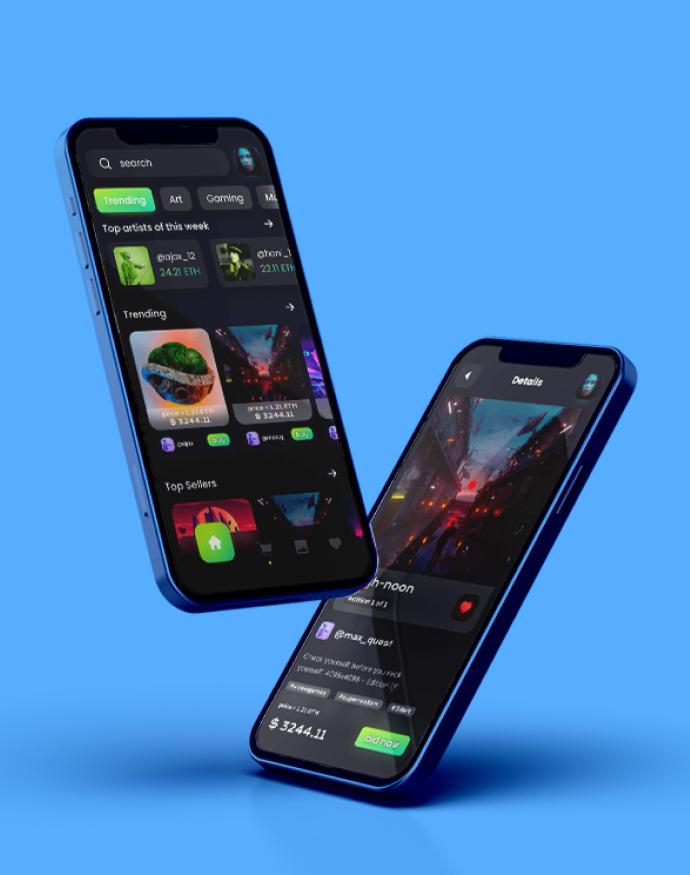


Gaurav Patil